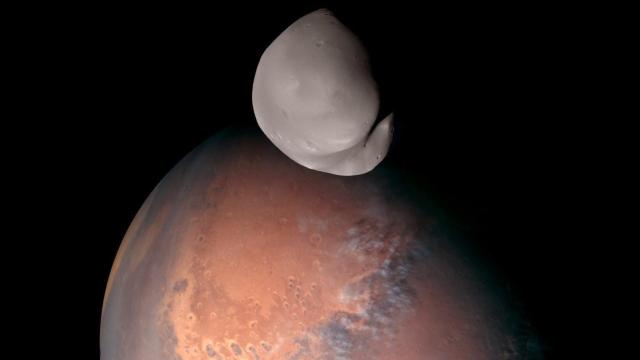For more than two years, the UAE’s Hope probe has been orbiting Mars to gain new insights about the planet’s atmosphere. But a slight change to its orbit placed the Emirati mission closer to Mars’ moon Deimos, revealing a possible planetary origin to the awkwardly shaped space rock.
New observations by the Emirates Mars Mission (EMM) suggest that Deimos may not be a captured asteroid, as scientists previously thought, but instead may have once been a part of the Red Planet itself. The findings were shared on Monday at the European Geosciences Union’s general assembly, which is currently underway in Vienna, Austria until April 28.
Deimos is the smaller of the two Martian moons and orbits the Red Planet at a much farther distance than its larger counterpart, Phobos. The tiny, lumpy celestial body is around 14 km by 11 km by 11 km in size and circles Mars once every 30 hours, according to NASA. Very little is known about Mars’ two moons, and even less so about Deimos. The closest approach to Deimos was made by the Viking 2 orbiter in 1977, which flew at a distance of 30 kilometres from the moon.
“We are unsure of the origins of both Phobos and Deimos,” Hessa Al Matroushi, EMM science lead, said in an emailed statement. “One long-standing theory is that they are captured asteroids, but there are unresolved questions about their composition.”
In January, the Hope probe performed an orbital manoeuvre to be able to make planet-wide observations of Mars at a greater distance. The change in orbit allowed the spacecraft to get up close with Deimos, performing a series of flybys that have now revealed some tantalising new clues to the object.
Hope flew as close as 100 kilometres to Deimos, capturing a series of high-resolution images and the first observations of the moon in extreme and far ultraviolet light. These revealed that Deimos’ composition is not consistent with that of an asteroid but rather similar to the composition of Mars, which is largely covered in basalt. This suggests that Deimos may have formed following a large impact on Mars that separated a chunk of the planet and catapulted it into orbit.
“We have a unique opportunity with Hope, to characterise the composition, thermophysics, and detailed geomorphology of Deimos with these new observations,” Justin Deighan, EMM deputy science lead, said in the statement. “We expect to build a better understanding of both Phobos and Deimos’ origins and evolution and advance our fundamental understanding of these two satellites of Mars.”
The Hope probe launched in July 2020, reaching Mars in February 2021. The Emirati space venture marked the first interplanetary mission by an Arab country, signalling a new era for the United Arab Emirates’ space ambitions. The Mars mission was originally meant to last for two years but was recently extended for an additional year, orbiting Mars once every 55 hours.
